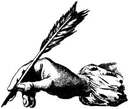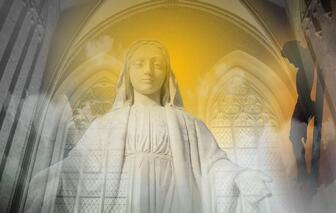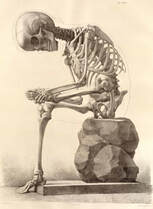
By M.P. Pellicer | Stranger Than Fiction Stories
Some ghost stories of yesteryear, of those that do not lie quietly in their graves. 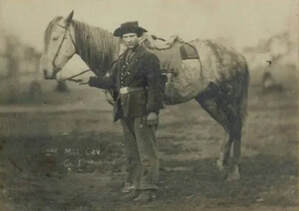 Who was the mysterious soldier Charles Reed saw that day? Who was the mysterious soldier Charles Reed saw that day?
CHATTANOOGA
For the first two years of the Civil War Charles Reed drove a hack to take dead soldiers from the battle field in West Virginia to where they would be shipped home. There were so many bodies that the practice was discontinued. He told the following story, stipulating that he was familiar with what a dead body looked like. In the fall of 1865, he was living in Atlanta and was returning home from the site of the battlefield of July 21, 1864. He was employed to cut wood. The sun was setting when he saw about 200 feet in front of him a Confederate soldier in uniform, and mounted on a sorrel horse suddenly appear in the road. The rider receded from him and soon vanished as suddenly as it had appeared. When he reached where the soldier was seen, there were no marks on the road. It was then he realized it was a ghost. 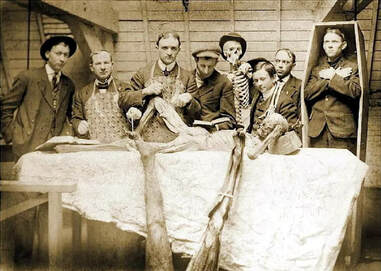 Medical students with cadaver c.1890 Medical students with cadaver c.1890
ST. LOUIS
While dissecting a body during the winter of 1888, a medical student found a peculiar malformation of the heart in a body he was dissecting. He removed the heart, which had the main arteries entering from the left instead of the right side and preserved it in alcohol. Several days after doing this he had a strange feeling that something was following him. If he was in the dark he looked behind, because he felt someone was near him. But there was no one there. Almost two weeks later he woke up suddenly one night, and felt the presence in his room. Light came into his room through a window. The only place he couldn't see was a bookcase near the head of his bed, where he kept a dozen or more anatomical specimens. Among them was the peculiar heart. Standing with its gaze fixed on the bottle was the shadowy figure of a man. He knew it was a ghost since he could see the shape of the books and bottles through him. It had a sickly phosphorescent glow around it. On its back was a large guano sack, which it wore like a shawl and the remainder of its body was naked. The student shouted in surprise which attracted the attention of the ghost who turned around came to the bedside, and he heard a voice say, "Do you not know me?" The student was so scared he couldn't answer. "Wretch!" exclaimed the ghost, "You have taken away my heart, and there it is in a preserve bottle!" He still couldn't answer and the ghost continued: "I cannot rest while my heart is in that bottle. I shall follow you while it remains there. I have come to demand my heart of you!" The student seized the bottle and handed it to the ghost. The ghost made to carry it away, but instead it fell to the floor and shattered. The heart rolled on the floor and the ghost placed both hands on it, and a pale light came from the heart. The ghost's hands were full of this light, and he placed them on his chest. "I have my heart now! Promise me you will bury the rest of it with my body and I will go, never to return again." The student promised and the specter disappeared through the open window. 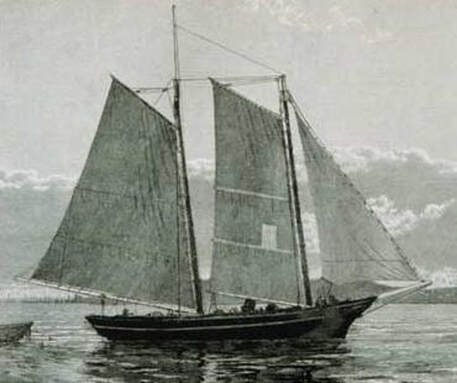 Once a ship developed a reputation for being unlucky it was difficult to secure a crew for it Once a ship developed a reputation for being unlucky it was difficult to secure a crew for it
PHILADELPHIA
When the schooner George B. McFarland launched, a psychic from Portland, Maine claimed he had received a communication from the other side, announcing that the spirit of Captain Kidd would take possession of the vessel. The medium said that any ship which Capt. Kidd took over would never be lucky. It turned out his prediction was correct. The vessel was never water tight since her launch. Her first commander, Capt. Strong gave her up after two or three voyages as a hopelessly unlucky vessel. The captain's brother took command of the ship, and lost money through the next 3 voyages. He abandoned her in mid-ocean, the crew being landed in Europe. She was towed to a European port after being found adrift at sea. She was refitted and taken over by a new master. Two days after she sailed the new captain suffered a broken leg, after being knocked down during a squall. Sailors aboard the McFarland said that ghostly carpenters haunted the vessel and were always at work. Sounds of sawing and planking would always be heard in the hold at night, as if they tried to cut the keel asunder and sink the ship. On many occasions the crews rushed out of the forecastle, shouting that hands had thrust them out of their bunks. On more than one occasion the entire crew jumped overboard, and swam ashore while the ship was in port to escape from the evil spirits. There was always great difficulty in securing a crew for the vessel, as those who served a single voyage never returned. In June 1889, the schooner George B. McFarland was once more abandoned at sea, and it was reported by another ship that her boats had been launched and the pulleys and tackle for the life boats were still in the water. Her hold was full of water, and the Orinoco set the wreck on fire in order to remove the possibility of a collision. 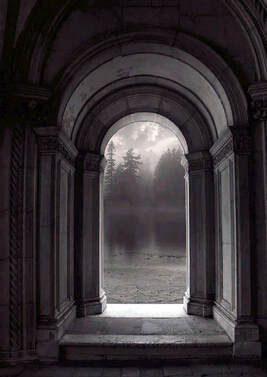 Was this a family banshee that announced a family member's death? Was this a family banshee that announced a family member's death?
SAN FRANCISCO
Josephine Schroder, a dressmaker by profession divorced her husband in 1889, citing that he treated her cruelly. While her child was dying he slept "blissfully entirely oblivious to the fact that a few feet away his daughter was dying." She described the following, "Yes, and a rap came at the door. I did not believe him when he told me that some ghostly visitant had always rapped upon the door when there was a death in his family. Now I do believe him. I heard the raps, I opened the door and nobody was there. I do not know what this rapping means. Friends and neighbors have heard it as well as myself. Mr. Schroder is not a spiritualist. We have never had a teacher of that doctrine in our home in Fulton Street. But it is all ended now." Mrs. O'Keefe a neighbor was present when the child passed away. She also heard the raps, and knew her "death summons had come." Richard Schroder said, "I don't believe in spiritualists at all, but I do know this: Before my brother's death, and before my sister's death, a rapping came at the door. I don't pretend to explain it. I only know it is so. Neighbors have heard it. I cannot doubt the evidence of my own senses. My father was a contractor. He was run over by a lumber wagon in 1865. Shortly before his death there came that tap, tap, tap at the door. My mother hurried to see who had called but there was not a soul in the hallway. In 1866, my sister died in Chicago. On the night of her death there was a rapping on the door. At my brother's death there was the same mysterious rapping. I can't account for it. My folks were Presbyterians: I am a Protestant. I don't believe in haunted houses. Neither do I believed that any of the boys was trying to fool me." Schroder had worked for 7 years at the Fulton Iron Works and was reputed as sober and reliable. Was this rapping the same as a family banshee? 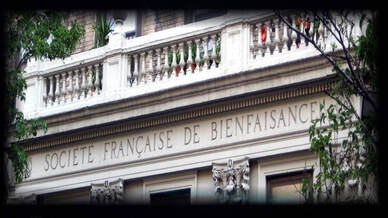 Societe Francaise de Bienfaisance Societe Francaise de Bienfaisance
NEW YORK
In the 19th century the Societe Francaise de Bienfaisance established a hospital on 14th street, New York to treat the French community. Eventually a second building was opened on 34th Street. It was around 1889, that rumors were whispered of an unquiet spirit residing there even though no one had actually seen anything. However once per week in the middle of the night the sound of a woman's sobbing, a hurried opening and closing of doors, a light footstep running and the swish of draperies along the hall, a heavier step behind, panting breaths, a scuffle, a stifled scream, a sound of heavy blows, a fall ,silence, only broken by a hurried descent of the staircase and opening and shutting of the front door. The occurrence is a mystery, none know what happened and to whom that causes this reenactment. 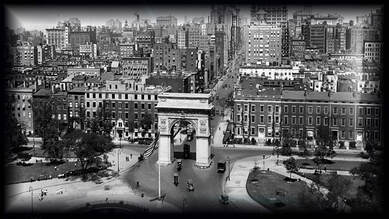 Washington Square Washington Square
At No. 71 Washington Square there is a sighting of an old man dressed in the style of 50 years before. He is solid looking, and stoops slightly and walks with a cane. He also sighs frequently in a heartfelt way as if he was grieving. No one knows his name. When he reaches the basement of the house he always stops, gives a sigh and a groan and goes down the steps through a closed door. He was noticed the first time opposite No. 10 West Washington Place. He has been seen as late as midnight and as early as 10 p.m.
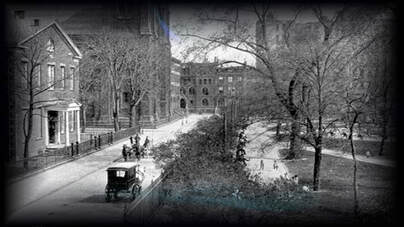 Stuyvesant Square Stuyvesant Square
In a pretty but old-fashioned house (by 1889 standards) in Stuyvesant Square stood empty for several years. In 1883, a man, his wife and small daughter moved there. The couple allowed their daughter to play in the empty attic which had apparently been arranged for a children's play room long before. There was a fireplace and a large fireboard in front of it. The mother noticed her daughter would slip away repeatedly to go to the attic, and when she asked why she liked it up there so much, the child said she like to play with the funny little boy with lots of buttons on his jacket. The girl said he would go to where the fireboard was.
The father was an old sea captain, and he found out the house had been occupied by an Englishman named Cowdery who had three children, two boys and a girl. One of the boys was an "idiot" who was supposed to have fallen into the East River, as his cap was found there, and he had always liked the river when taken there by his nurse. Soon after this Mr. Cowdery moved West. The fireboard was taken down and in the wall by the side of the chimney the body of the unfortunate boy was found. The back of the skull was crushed in. He still had the dark blue jacket on with four rows of buttons on the front. The bones were buried and the affair kept quiet, but the captain moved his family away from the house. 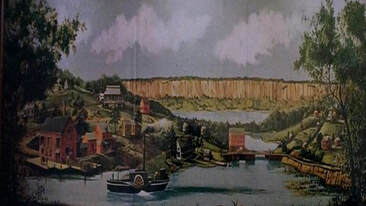 Washington Heights c.1850 Washington Heights c.1850
Near Washington Heights, a lady was a guest at Mr. Beekman's house along with many other visitors. She was given the room which was once occupied by the owner's son who had died. She was young, and normally could sleep anywhere but found it impossible to sleep in the room. She felt an uncontrollable impulse to walk restlessly about the room, and at the same time felt a "great depression of spirits", which was quite unlike her. She sat down and felt a pain in her throat, a suffocation that caused her to faint and fall to the floor. The housekeeper found her and she was revived. She found out the owner's son had cut his throat in the very same chair, and had fallen and died on the spot where she fell.
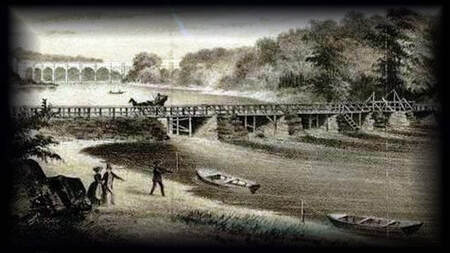 McComb's Dam c.1850 McComb's Dam c.1850
This same woman went to an old-fashioned hotel that was near McComb's Dam, which spanned the Harlem River, between Manhattan and the Bronx. She was attending a large party. The small hotel was very full, and some rooms had not been used for some time.
She shared a room with another girl. They were already in bed when the door opened noiselessly and a lady with what she thought was a peculiar night dress on, and with long hair unbound came into the room. She went to a wardrobe in the corner. She took their dresses and threw them on the floor and counted all the garments hanging there. Then she went to the bureau and looked over every piece of linen, counting them in a whisper. She appeared so life-like that the girls never suspected she was a ghost even when she left the room and closed the door behind her. The next morning was raining and they ate breakfast at the hotel. The lady saw a photograph in the parlor of the visitor. Strangely the landlady asked if she had slept well. She told the story of what happened the night before. The landlady said the landlord's first wife had been very fond of dress and before she died declared that she could never lie easily in her grave if she thought anyone else was to wear her clothes, and that she would come back every Saturday night and count her clothes. "And she has" said the landlady, "but she never harms anybody. She just counts them and then goes quietly away." Source - St. Louis Globe-Democrat
0 Comments
Your comment will be posted after it is approved.
Leave a Reply. |
Stranger Than Fiction StoriesM.P. PellicerAuthor, Narrator and Producer Archives
July 2024
Categories
All
|
Stories of the Supernatural
- Stories of the Supernatural
- Miami Ghost Chronicles
- M.P. Pellicer | Author
- Stranger Than Fiction Stories
- Eerie News
- Supernatural Storytime
-
Astrology Today
- Tarot
- Horoscope
- Zodiac
-
Haunted Places
- Animal Hauntings
- Belleview Biltmore Hotel
- Bobby Mackey's Honky Tonk
- Brookdale Lodge
- Chacachacare Island
- Coral Castle
- Drayton Hall Plantation
- Jonathan Dickinson State Park
- Kreischer Mansion
- Miami Biltmore Hotel
- Miami Forgotten Properties
- Myrtles Plantation
- Pinewood Cemetery
- Rolling Hills Asylum
- St. Ann's Retreat
- Stranahan Cromartie House
- The Devil Tree
- Trans-Allegheny Lunatic Asylum
- West Virginia Penitentiary
- Paranormal Podcasts
"When misguided public opinion honors what is despicable and despises what is honorable, punishes virtue and rewards vice, encourages what is harmful and discourages what is useful, applauds falsehood and smothers truth under indifference or insult, a nation turns its back on progress and can be restored only by the terrible lessons of catastrophe."
- Frederic Bastiat
- Frederic Bastiat

Copyright © 2009-2024 Eleventh Hour LLC. All Rights Reserved ®
DISCLAIMER
DISCLAIMER
 RSS Feed
RSS Feed








